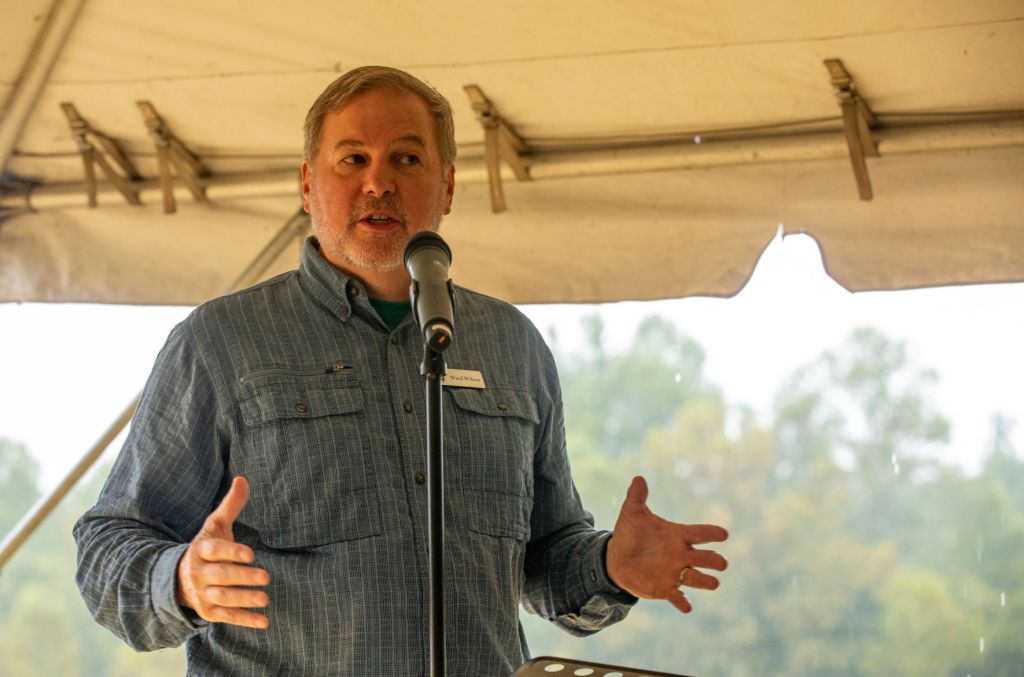Conservation partners cheer largest dam removal in state history
Published 2:45 pm Monday, September 20, 2021

- Ward Wilson of the Kentucky Waterways Alliance addresses the crowd at the Green River Lock and Dam #5 removal in Roundhill on Monday September, 20, 2021.
ROUNDHILL – Despite heavy rain and muddy conditions, officials from five conservation organizations gathered Monday at Green River Lock and Dam No. 5 in Butler County to recognize the largest dam removal in state history.
The estimated $4.6 million dam removal project began in June and was funded through the U.S. Fish and Wildlife Service’s National Fish Passage Program.
The dam has already been breached, and the lock and chamber portion has been removed. Final completion of the project is expected in late October.
Representatives from The Nature Conservancy, U.S. Fish and Wildlife Service, U.S. Army Corps of Engineers, Kentucky Department of Fish and Wildlife Resources and Kentucky Waterways Alliance said the project will result in a healthier, more accessible and safer river.
“If you want to take away one message from today, I hope you recognize that removing Lock and Dam No. 5 on the Green River is a really big deal,” Kentucky Nature Conservancy Director David Phemister said. “This has been about 20 years in the making with assertive effort over the last six (years). It’s just a tremendous win for the river and the people who love it.”
Green River Lock and Dam No. 6 was removed in 2017. When this project is completed, a total of 197 miles of the Green River will be restored to free-flowing conditions with both dams removed.
The structure formerly consisted of a 301-foot dam, a 360-foot by 56-foot lock chamber along the right descending bank, two 30-foot mooring cells upstream of the lock chamber, a 266-foot upstream guide wall and a 300-foot downstream guide wall.
The dam is being removed by personnel with the U.S. Fish and Wildlife Service’s Aquatic Habitat Restoration Team.
Phemister called the project an “ecological and economical victory” for the area.
“There are few things better than floating the Green River on a sunny day,” he said. “When Lock and Dam No. 6 came out, all of a sudden people could safely float from Houchins Ferry all the way to Brownsville. Removing this dam will open up a similar stretch of the Green River.”
After completion, The Nature Conservancy will take ownership of the site from the Corps of Engineers. The organization will then work to ensure the river is accessible to the public.
Col. Eric Crispino, Corps of Engineers district commander, said the commitment from all five organizations was a showcase of teamwork.
“The removal of this lock and dam is a great partnership opportunity,” he said. “It’s through partnerships like these that we are able to develop solutions to water resource challenges that impacts each of our different organizations. This project also illustrates the importance of partnerships.”
Lock and Dam No. 5 had stood unused for 70 years, and U.S. Fish and Wildlife Field Supervisor Lee Andrews said it presented a barrier to boat traffic while also being a public safety risk.
“I think we can all take some measure of benefit from the fact that maybe there won’t be another family who has to deal with a loved one who gets trapped in the dam waters and drowns,” Andrews said.
The dam previously created a pooled condition in the river with lower oxygen levels, more sediment and higher temperatures – all of which are negative for aquatic life and the river’s health.
Dave Dreves, acting fisheries division director of the Kentucky Department of Fish & Wildlife, was also present and spoke to the ecological benefits of the dam’s removal.
“This is one of the most biodiverse river systems in the country,” Dreves said. “It is home to 150 fish species, more than 70 mussel species and 43 endemic species (species existing nowhere else in the world). Removing this dam will allow the overall fishery to improve. The population of the black bass species (primarily the smallmouth bass populations) will greatly increase. It will have a huge impact.”
– Follow reporter John Reecer on Twitter @JReecerBGDN or visit bgdailynews.com.






